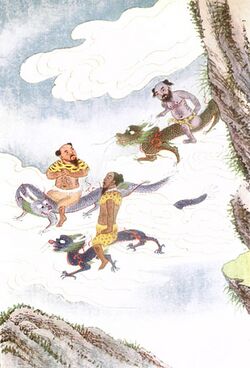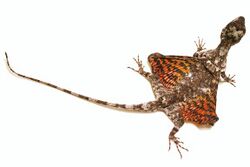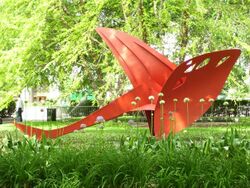Feilong
Topic: Unsolved
 From HandWiki - Reading time: 7 min
From HandWiki - Reading time: 7 min
Feilong (simplified Chinese: 飞龙; traditional Chinese: 飛龍; pinyin: fēilóng; Wade–Giles: fei lung; lit. "flying dragon") is a legendary creature that flies among clouds in Chinese mythology. Feilong is a proper name, and is often used as a title for other ideas and objects.
Word
The Chinese dragon name feilong combines fei 飛 or 飞 "fly; flying; hover; flutter" and long 龍 or 龙 "dragon". This loanword 飛龍 is pronounced as Japanese hiryū (飛竜), Korean biryong (비룡), and Vietnamese philong. The inverted Longfei 龍飛 was an era name (396–399 CE) during the Later Liang Dynasty.[1]
The (121 CE) Shuowen Jiezi, the first Chinese character dictionary, uses feilong to define da 龖 (written with 2 龍 dragons) "flying dragon; appearance of a dragon in flight".
Early references
Chinese classic texts frequently mention feilong 飛龍 "flying dragons". The examples below are roughly arranged in chronological order, although some heterogeneous texts are of uncertain dates.
Yijing
The (5th–3rd centuries BCE) Yijing "Book of Changes" first uses feilong to symbolize a daren 大人 "great person; accomplished person". Qian 乾 "The Creative", the first hexagram, says,[2] "Nine in the fifth place means: Flying dragons in the heavens. It furthers one to see the great man." The "Commentary on the Decision" (彖傳[3]), explains, "Because the holy man is clear as to the end and the beginning, as to the way in which each of the six stages completes itself in its own time, he mounts on them toward heaven as though on six dragons." And the "Commentary on the Images" (象傳[4]), says, "'Flying dragon in the heavens.' This shows the great man at work."
Many later texts, such as the Zuozhuan, Shiji, and Hanshu histories, quote this "Flying dragons in the heavens" from the Yijing.
Hanfeizi
The (3rd century BCE) Hanfeizi (難勢,[5]) quotes Shen Dao contrasting feilong 飛龍 with tengshe 螣蛇 "ascending/floating snake" to explain the Legalist concept of shi 勢 "political power; strategic advantage".
Shen Tzu said: "The flying dragon mounts the clouds and the t'eng snake wanders in the mists. But when the clouds dissipate and the mists clear, the dragon and the snake become the same as the earthworm and the large-winged black ant because they have lost that on which they ride. Where men of superior character are subjugated by inferior men, it is because their authority is lacking and their position is low. Where the inferior are subjugated by the superior, it is because the authority of the latter is considerable and their position is high.
Ames notes this Shen Dao quotation "is very close both in wording and in substance to" the Shenzi (威德) fragment, and "indeed, it could conceivably be an expansion and elaboration on it."
Lüshi Chunqiu
The (c. 3rd century BCE) encyclopedic Lüshi Chunqiu (古樂 "Music of the Ancients",[6]) uses Feilong 飛龍 "Flying Dragon" as the name of a music master for the legendary ruler Zhuanxu
The Sovereign Zhuanxu was born at Ruo River and lived at Kongsang. Then he ascended to become a Sovereign who was truly a match for Heaven. When the winds true to the eight directions circulated, they made sounds like hya-hya, tsied-tsied, and tsyang-tsyang. The Sovereign Zhuanxu, being fond of these sounds, ordered Feilong to compose music in imitation of the Eight Winds, naming them "Supporting the Clouds" and using them in the worship of the Supreme Sovereign. He then ordered the [鼉] water-lizard to lead them as singing master, so the water-lizard reclined and, using his tail to beat his belly, made the sound bung-bung.
Zhuangzi
The (3rd–2nd centuries BC) Daoist Zhuangzi (1)[8] describes a shenren 神人 "holy person" riding a feilong
He said that there is a Holy Man living on faraway Ku-she Mountain, with skin like ice or snow, and gentle and shy like a young girl. He doesn't eat the five grains, but sucks the wind, drinks the dew, climbs up on the clouds and mist, rides a flying dragon, and wanders beyond the Four Seas. By concentrating his spirit, he can protect creatures from sickness and plague and make the harvest plentiful.
Chuci
The (3rd–2nd centuries BCE) Chuci uses feilong in two poems. The Li Sao 離騷 "On Encountering Trouble"[9] says,
Harness winged dragons to be my coursers; Let my chariot be of fine work of jade and ivory! How can I live with men whose hearts are strangers to me? I am going a far journey to be away from them.
The "Goddess of the Xiang" 湘君[10] mentions feilong twice.
North I go, drawn by my flying dragon, Steering my course to the Dong-ting lake: My sail is of fig-leaves, melilotus my rigging, An iris my flag-pole, my banner of orchids. Gazing at the distant Cen-yang mooring, I waft my magic across the Great River. ... The stream runs fast through the stony shallow, And my flying dragon wings swiftly above it. The pain is more lasting if loving is faithless: She broke her tryst; she told me she had not time.
Huainanzi
The (2nd century BCE) Huainanzi uses feilong in two chapters.
"Evolution of Animals and Plants" (墬形訓,[11]) mentions feilong with yujia 羽嘉 "winged excellence", fenghuang 鳳皇 "phoenix", and luan 鸞 "a legendary phoenix-like bird; simurgh".
Winged Excellence gave birth to Flying Dragon. Flying Dragon gave birth to the phoenix (fenghuang). The phoenix gave birth to the simurgh (luan). The simurgh gave birth to ordinary birds. Feathered creatures in general are born from ordinary birds.
Edward H. Schafer first translated luan as simurgh "a giant winged creature in Persian mythology".[12]
"Generalship and the Prevention of Anarchy" (兵略訓,[13]) describes Daoist movement with the animal metaphors of luan, qilin (instead of yujia), fenghuang, and feilong.
The movements of the Tao-inspired are like a spirit's emergence and a demon's action, unexpected and sudden, like the sudden shining of the stars and their sinking into darkness again; like the rising of the fabulous bird Luan, and the excitation of the Lin, like the flight of the phoenix or the ascension of the dragon.
Baopuzi
The (c. 320 CE) Daoist Baopuzi by Ge Hong mentions Feilong 飛龍 "flying dragon" and uses it as a graphic variant for the draconic mountain spirit Feifei 飛飛 "fly fly".[14]
Feilong occurs describing a Daoist xian 仙 "transcendent; immortal" (6),[15] "When my eyes have square pupils and my ears grow from the top of my head; when, driving a flying dragon and riding a cloud of good fortune, I shall mount above the darted lightning and reach Lighted-from-below, how will you be able to interrogate me? If you see me, you will then cry out that it is a heaven or an earth deity, or a strange sort of man. It will never occur to you to say that I am something produced by mere study!"
Feifei occurs with kui 夔 "a one-legged demon" in a list of shanxiao 山魈 "mountain spirits" (l7),[16] "Another is like a dragon, variegated in color and with red horns, the name being Fei-fei. Whenever one of these appears, shout its name, and it will not dare harm you."
Other texts
Feilong occurs in many additional contexts. Carr cites two examples.[17] The Xijingfu 西京賦 "Western Metropolis Rhapsody", by Zhang Heng (78–139 CE), used feilong as an alternate name for the mythical bird called longque 龍雀 "dragon sparrow". Bicheng 筆乘 "Collection of Notes", by Jiao Hong 焦竑 (1540–1620 CE), described the feilong as having "a dragon's head, phoenix's tail, and multicolored patterns", and equated it with the wind god Feilian 飛廉.
Proper names
Feilong, Hiryū, and Flying Dragon commonly occur in names.
Chinese Feilong (flying dragon) is also used to name:
- Feilong, a jumping kick in martial arts
- Fei Lung, a British-built gunboat in the Guangdong Fleet
- Fei Long (FL), a family of Silkworm missiles (e.g., the C-101)
- Fei-Long, a video game character in the Street Fighter series
- Fei Long, a tribe in Survivor: China television series
- FEILONG, call sign of China Flying Dragon Aviation
- Fei lung maang jeung (飛龍猛将) or Dragons Forever, a Hong Kong action cinema
- Yang Feilong (楊飛龍), a 3rd-century ruler of Chouchi
- Fu Feilong (苻飛龍), a 4th-century deputy of Fu Pi
- Ling Fei-long (嶺飛龍), a character in the Dragon Fist manga
- Liu Fei Long (刘飛龍), a character in Target in the Finder manga
Japanese Hiryū (flying dragon) names:
- Hiryū, a Japanese aircraft carrier
- Hiryū, a type of Mitsubishi Ki-67 medium bomber
- Hiryū, a chess piece in Dai shogi
- Hiryū no ken (飛龍の拳) Flying Dragon, a video game
- Hiryū002, a train in The Galaxy Railways anime series
- Strider Hiryu, a video game character
- There is a minor My Hero Academia (a manga and anime) character named Hiryu Rin. He is from China and his Chinese name is Feilong Lin.
English has additional Feilong "Flying Dragon" names.
- Feilongus, a genus of pterosaurs
- Feilongshania, a genus of trilobites
- Flying dragon or Draco volans, a species of Agaminae gliding lizards
- Flying Dragon, a sculpture by Alexander Calder
References
- The Songs of the South: An Anthology of Ancient Chinese Poems by Qu Yuan and Other Poets. Penguin. 1985.
- Alchemy, Medicine and Religion in the China of A.D. 320: The Nei Pien of Ko Hung. MIT Press. 1966.
- Wilhelm, Richard; Baynes, Cary F. (1967). The I Ching or Book of Changes. Bollingen Series XIX. Princeton University Press.
Footnotes
- ↑ Ingersoll,Ernest, et al., (2013). The Illustrated Book of Dragons and Dragon Lore. Chiang Mai: Cognoscenti Books.
- ↑ Tr. Wilhelm & Baynes 1967, p. 9.
- ↑ Tr. Wilhelm & Baynes 1967, p. 371.
- ↑ Tr. Wilhelm & Baynes 1967, p. 371.
- ↑ Tr. Ames, Roger T. 1983. The Art of Rulership: A Study of Ancient Chinese Political Thought. University of Hawaii Press. p. 74.
- ↑ Tr. Knoblock, John and Jeffrey Riegel, trs. 2000. The Annals of Lü Buwei: A Complete Translation and Study. Stanford: Stanford University Press. p. 148.
- ↑ Werner, E.T.C. (1922). Myths & Legends of China. New York City: George G. Harrap & Co.. Available online at Project Gutenberg.
- ↑ Watson, Burton, tr. 1968. The Complete Works of Chuang-Tzu. Columbia University Press. p. 33. ISBN:9780231031479.
- ↑ Hawkes 1985, p. 77.
- ↑ Hawkes 1985, p. 107.
- ↑ Tr. Major, John S. 1993. Heaven and Earth in Early Han Thought: Chapters Three, Four, and Five of the Huainanzi. SUNY Press. p. 209. Cf. Visser, Marinus Willern de. 1913. The Dragon in China and Japan. J. Müller. p. 65.
- ↑ Schafer, Edward H. 1963. The Golden Peaches of Samarkand, a Study of T'ang Exotics. University of California Press. pp. 38, 288.
- ↑ Tr. Morgan 1933:196.[full citation needed]
- ↑ Eberhard, Wolfram. 1968. The Local Cultures of South and East China. E. J. Brill. p. 58.
- ↑ Ware 1966, p. 111.
- ↑ Ware 1966, p. 287.
- ↑ Carr, Michael. 1990. "Chinese Dragon Names", Linguistics of the Tibeto-Burman Area 13.2:87-189. p. 115.
 |
 KSF
KSF


